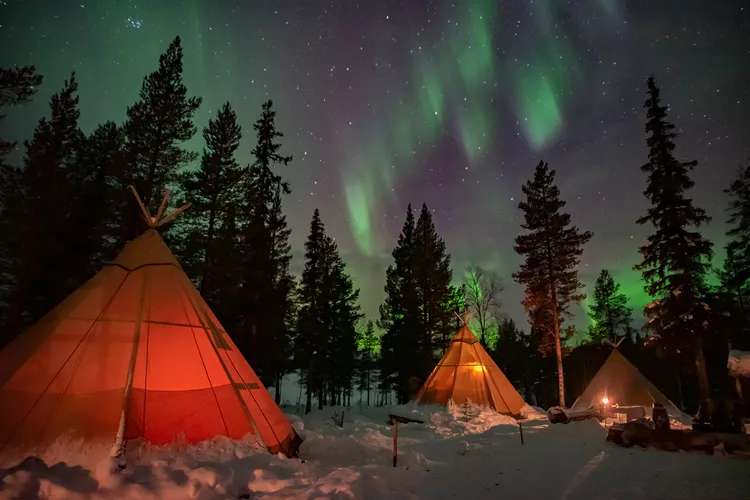Explore the Wonders of Swedish Lapland
1. Discovering Lapland
The northernmost stretches of Sweden are part of a greater Nordic region known as Lapland. Tourism here is a relatively recent phenomenon, stemming back to 1989 when the world’s first ice hotel opened in the remote village of Jukkasjärvi (population 548). Over the years, a handful of novelty lodges have emerged, attracting a growing group of travelers eager for adventures and aurora borealis sightings. Guests can stay in artfully designed treehouse suites nestled in the towering pine forests of Harads or enjoy an overnight stay in the world’s tallest all-wooden structure located in the cosmopolitan borough of Skellefteå.
:max_bytes(150000):strip_icc():format(webp)/northern-lights-SAMISWED0222-f7ea1bab8f114c1e8255a5bd492e9cc5.jpg)
2. Engaging with Sámi Culture
Although its emergence as a vacation spot for U.S. travelers is recent, Lapland’s cultural history is rich and deep, dating back thousands of years. The Sámi, a semi-nomadic people native to the region, are among Europe’s oldest known inhabitants. Engaging with these Indigenous stewards is crucial for a comprehensive visit to this area, especially for ecotourism enthusiasts. Fortunately, opportunities for meaningful experiences are expanding as the Sámi embrace their role in welcoming tourism to their homeland.
“I wanted to bring people into our land to enjoy our world and learn about our way of life,” explains Lennart Pittja, founder of Sápmi Nature Camp. The camp is situated amongst the rugged mountains of the Laponia World Heritage Site, just a 90-minute drive from Gällivare. “I provide a glamping experience with traditional lavvu tents, equipped with heaters and beds. From there, we explore nature and Sámi culture in a natural setting.”
:max_bytes(150000):strip_icc():format(webp)/lavvu-interior-SAMISWED0222-97279395aa34400f8abb417630e11bfa.jpg)
During the summer, activities include wildlife observation, such as spotting moose and golden eagles along the Stuor Julevädno river. In winter, visitors can enjoy snowshoeing or traditional wooden skiing while searching for the breathtaking Northern Lights. Regardless of the season, reindeer play a prominent role in the Sámi lifestyle.
“I grew up in a reindeer-herding family, so I have many stories to share about our life with them,” Pittja continues. “Much like other Indigenous cultures, our knowledge was passed down through storytelling for centuries before we could formally write in Sámi. This rich oral tradition is part of our identity, and visitors appreciate our storytelling.”
:max_bytes(150000):strip_icc():format(webp)/reindeer-SAMISWED0222-f8acd52a478d4ff09184522043ba033b.jpg)
3. Culinary Experiences in Lapland
Food enthusiasts will appreciate the culinary offerings shaped by the Sámi way of life. Helena Länta, a reindeer herder and specialty meat supplier in Jokkmokk, collaborates with local forager Eva Gunnare to guide guests on an epicurean journey. This experience, called Essence Of Lapland, involves a four-hour immersive tasting menu showcasing the eight distinct seasons experienced by the Sámi, complete with approximately 25 unique flavors. However, participants should be prepared to invest $295 per person for this culinary adventure.
For summer visitors, an outdoor dining experience with Huuva Hideaway in Liehittäjä offers traditional Sámi cuisine in a reindeer corral, along with a mixology class that incorporates local ingredients, all for €125.
:max_bytes(150000):strip_icc():format(webp)/sami-food-SAMISWED0222-0f62fcd076ac47408d629fcafd0ebd2b.jpg)
Moreover, visitors seeking Sámi cuisine can also find it in high-end restaurants across the region. For instance, the stunning Arctic Bath hotel features chef David Staf working with local ingredients to create inspired dishes while floating on the Lule River. The emphasis on sourcing from local Sámi purveyors ensures an authentic culinary experience.
“Finding local voices is essential for an authentic experience,” says Alex Minnis, COO at Off The Map Travel. It’s crucial to pay attention to how tourism affects locals, and Lennart is both fascinating and committed to educating visitors on his culture.
The Sámi involved in tourism are enthusiastic about sharing their heritage with travelers. As Pittja notes, the perspective gained from 7,000 years of connecting with this land is invaluable. For those focused solely on modern luxury and social media postings, a deeper understanding may be missed.
“For me, this isn’t just about hospitality; it’s about preserving life,” Pittja states. “Ecotourism fosters value by maintaining nature. Unlike corporations that view nature as a commodity, we depend on the land for our reindeer. Without clean water, the other luxuries in life hold little significance.”




